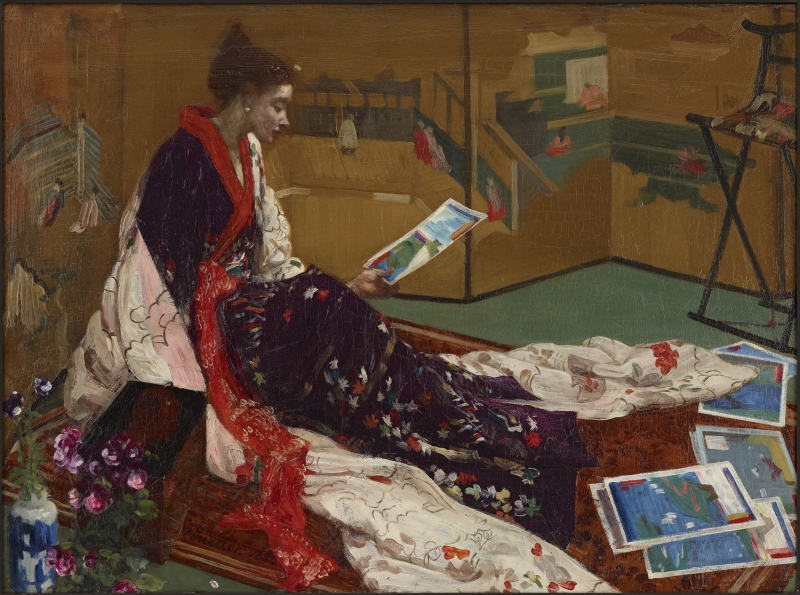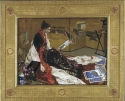Provenance
- 1873: sold by Whistler to Cyril Flower (1843-1907) ;
- 1904: sold by Flower through William Stephen Marchant (1868-1925), London art dealer, to Charles Lang Freer (1856-1919) , Detroit;
- 1919: bequeathed by C. L. Freer to the Freer Gallery of Art.
It was sold by Flower through Marchant to C. L. Freer on 19 June 1904, for £3000 plus 10 per cent commission.
Exhibitions
- 1865: 97th Exhibition of the Royal Academy of Arts, London, 1865 (cat. no. 90) as 'The golden screen'.
- 1873: Sixth Exhibition of the Society of French Artists [Summer Exhibition], Deschamps Gallery, London, 1873 (cat. no. 109) as 'The Golden Screen – Harmony in purple and gold (No. 2)'.
- 1892: Nocturnes, Marines & Chevalet Pieces, Goupil Gallery, London, 1892 (cat. no. 14) as 'Caprice in Purple and Gold: The Golden Screen'.
- 1904: 78th Exhibition of the Royal Scottish Academy of Painting, Sculpture and Architecture, Royal Scottish Academy, Edinburgh, 1904 (cat. no. 256) as 'The Golden Screen'.
- 1905: Œuvres de James McNeill Whistler, Palais de l'Ecole des Beaux-Arts, Paris, 1905 (cat. no. 8) as 'Caprice en pourpre et or. – L'Ecran doré. – (Caprice in Purple and Gold. The Gold Screen)'.
1865: Reviews of Whistler's work at the Royal Academy in 1865 were mixed but they make it clear that Whistler exhibited two Asian subjects: The Scarf [YMSM 059] and Caprice in Purple and Gold: The Golden Screen [YMSM 060]. Both were well hung, according to Philippe Burty (1830-1890), who wrote,
'ses deux Japonaises ont été justement considérées comme des mystifications, et les Académiciens, qui avaient le droit de les repousser, se sont montrés fort spirituels en les livrant au jugement des délicats par des places excellentes. Elles abondent en tons faux et délavés, choses singulières, puisque M. Whistler s'inspirait directement de ces feuilles d'albums japonais si franches et si riches.' 1
Translation: 'these two Japanese subjects are justly considered as mystifications, and the academicians, who had every right to reject them, were very spiritual [thoughtful? insightful?] in delivering them to the judgement of the refined by excellent places. They abound with false and faded tones, singular things, since Mr. Whistler was directly inspired by the leaves of Japanese albums, so fresh and so rich.'
The Pall Mall Gazette on 6 May 1865 described Whistler dismissively as 'An artist of remarkable power, but so eccentric that he can hardly hope for popularity' and added, 'He continues painting Japanese ladies in fanciful draperies. As studies of colour these pictures are bold, original and pleasing. They are always left unfinished, in a kind of dilettante fashion, which reminds us of some foreign painters.' Similarly, the Saturday Review, after describing the Symphony in White, No. 2: The Little White Girl [YMSM 052] as 'most gracefully felt, but less than half-painted', continued with an oblique reference to the Japanese subject:
'until Mr. Whistler chooses to put heads and hands on a level with screens and dresses, we fear that he will not rank above that class which the French name amateur-prodige.' 2
The Times categorised Whistler as eccentric, grouping him with English 'young painters' like Dante Gabriel Rossetti (1828-1882) and Ford Madox Brown (1821-1893) (neither of whom had anything in the exhibition!), Anthony Frederick Augustus Sandys (1829-1904), and Valentine Cameron Prinsep (1836-1904) (who also included Japanese artefacts in his Belinda (cat. no. 188). The art critic commented:
'Mr Whistler is the man at once of highest genius and most daring eccentricity of this school. He is equally capable of exquisite things or of gross impertinences, and this exhibition contains instances of both; of the former, in the "Little White Girl", of the latter, in his two sketches of Japanese and Chinese fabrics and screens, accompanied by slight caricatures of maidens of the flowery land, mere plays of colour, and imitation of textures, ugly in form and unfinished in execution.' 3
On the other hand, William Michael Rossetti (1829-1919) considered them 'unsurpassed in delicate aberrances and intricate haphazards of colour.' 4
1873: A few years later the painting was on show at the Society of French Artists and was described enthusiastically in the London Evening Standard:
'Mr. Whistler's canvases ... impart an air of novelty to the gallery. We know of no greater difficulty than to succeed in giving people who have not seen them a notion of what Mr. Whistler's pictures are like. The more important, perhaps, of those now exhibited is called "The Golden Screen Harmony," which at first sight seems an exquisite work of a Japanese artist. Mr. Whistler rightly finds wonders in the works of Japan, which suggest to him much of beauty expressed with a rapture (little known in Europe) on costly robes and porcelain, on cabinet and screen. Like a child he sports with these things, and fashions terraces and peoples them with graceful shapes of women, who glide about among flowers or painted screens, and butterflies of every hue are supposed to wing their way from shrub to shrub and mingle with the blossoms. "The Golden Screen" is an interior made up of many picturesque things and patterns rare as the colours which cunning Oriental artists know so well how to combine in contrasts vivid, without once in an age breaking the laws of harmony.' 5
1892:

Caprice in Purple and Gold: The Golden Screen, photo, Goupil Album, 1892, Glasgow University Library, Whistler PH5/6/8
The photographs taken for the Goupil Album in 1892 displeased Whistler, the photographic process having falsified the colour. He wrote to D. C. Thomson, complaining about 'those shocking reproductions of the Gold Screen!':
'Why, of all the pictures choose that one, so difficult in itself to reproduce at all, so absolutely unfitted in every way as a representative work because of the impossibility of even hinting at its atmosphere on account of the false rendering of its colour in photography and consequent hard black & whiteness! -How did it come about by the way that it was chosen? I don't remember your saying anything to me about it - and what possessed the people to turn it out in the absolutely damnable blues & violets! like the outside of a Spanish plum box or a case of Cuban cigars! gold tipped Colorados!' 6
Immediately after the show, Whistler wanted to borrow the painting for exhibition in Paris, but clearly this did not happen. 7 It was finally shown in Paris after Whistler's death, in one of the memorial exhibitions.
By the terms of C. L. Freer's bequest to the Freer Gallery of Art, the painting cannot be lent.
Notes:
1: Burty 1865 [more] , p. 561. See also The Examiner, 6 May 1865, which described 'Mr Whistler's Golden Screen and Scarf, Japanese studies from a Birmingham teaboard' as 'well hung'.
2: Saturday Review, 3 June 1865 [more] .
3: 'Exhibition of the Royal Academy. Second Notice', The Times, London, 8 May 1865, p. 8.
4: Rossetti 1867: [more] , p. 276.
5: 'Society of French Artists', London Evening Standard, London, 21 April 1873, p. 2. See also 'Society of French Artists', The Examiner, London, 26 April 1873, pp. 15-16, at p. 16, which describes it as 'having more the appearance of a complete and finished picture than the generality of Mr Whistler's productions.'
Last updated: 11th October 2021 by Margaret






